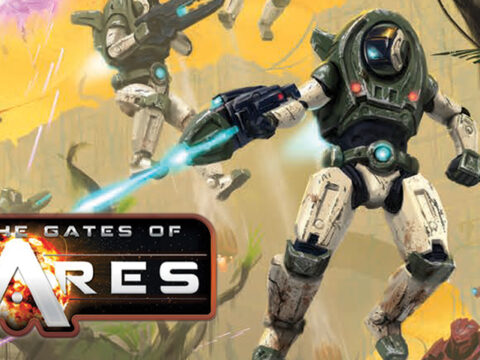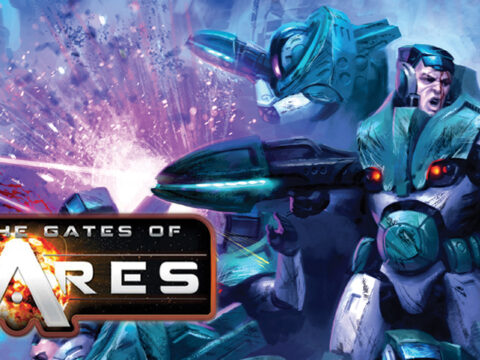We’ve just about completed sculpting the first batch of Boromite models for the Antares game, so this week I thought we’d take a look at the completed paint jobs of the Boromite gangers with mag guns and the Lavamites together with their handler. The final selection of Boromite troops are equipped with short-ranged mass-compactors – those are awaiting a proper paint-job from studio brushman Andres Amian. After that we have to finish off the various support weapons and their crews, some of which we’ve already seen as part of our update on support weaponry.
Rather than just show the new paint jobs I thought I’d take the opportunity to give our new models a stat line and talk about how these work. We are still tinkering with some of the details, but we have used our Boromites quite a bit now, so I think we can risk a stat-line or two. Here is a sample unit of your basic Boromite Gang Fighters.
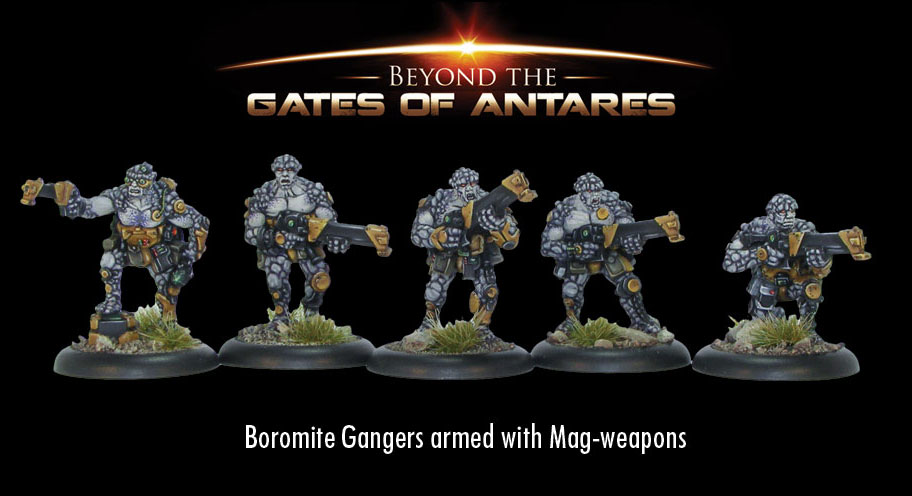
| BOROMITE GANG FIGHTERS | |||||||
| Unit: Gang Fighters | Ag | Acc | Str | Res | Init | Co | Special |
| 1 x Gang Leader: mag pistol and tractor maul or lectro-lash, reflex armour. | 4 | 5 | 6 | 6 | 6 | 9 | |
| 4 x Ganger: mag gun, reflex armour | 4 | 5 | 6 | 6 | 6 | 9 | |
In this case our sample unit comprises five models: a Gang Leader and four Gangers. The leader carries a mag pistol and a hand held weapon for close up fighting – this can be either a tractor maul or lectro-lash. The gangers carry longer-ranged mag guns. Both have reflex armour. Reflex armour is a basic type of kinetic field defence common to many combatants in the Antarean universe. This consists of an energy field suspended from metalised hard points located on the wearer’s armour or clothing. In the case of Boromites, these hard points take the form of separate multifunctional nanite receptor nodes fastened directly into the tough, horny skin of the individual concerned. One of their other functions is to identify the Guild to which the Boromite gang belongs.
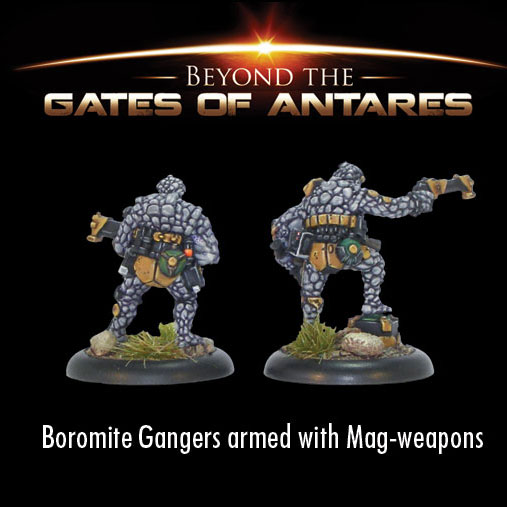
The stat line reads as follows Ag (Agility), Acc (Accuracy), Str (Strength) Res (Resist), Init (Initiative) and Co (Command). The value is a base test number for a D10, so you need to roll a D10 and score equal to or under the value shown to pass a test against that particular stat. In other words, to pass an Accuracy test our Boromite would need to roll a 5 or less, assuming no modifiers apply. Most folks will recognise this is a decimal system – a percentage expressed as a single multiple of ten – so a stat of 4 = a 40% chance of success, a stat of 9 = a 90% chance, and so on. I’ve done this deliberately to allow for super-detailing the game in the future by simply multiplying everything by ten and using a D100. That can wait for now though!
In the basic version of the Antares game, all infantry have a move rate of 5″ (M) and a run move rate 10″ (2M). This move rate isn’t included in the stat line. I might add it in later. For now at least, all infantry have the same move rate, so I’ve missed it out to keep the stat line as short as possible.
The Agility value (Ag) is not the move rate, but the stat we test against when moving through terrain that is hard going, when sprinting, and – in theory at least – in any situation that calls for physical agility and athleticism. So, let’s take the sprint move as an example. Any unit given a run order can either run (2M) or sprint (3M). A unit making a sprint moves three times its normal rate or 15″ over open ground, but once it has moved it must test its Agility. If this test is passed all is well. If the test is failed the unit becomes exhausted and suffers a pin marker. With a value of 4 our Boromites are slightly more cumbersome than the average human with a typical value of 5.
Accuracy and Strength are both used to strike at the enemy. Accuracy is the score required to hit when shooting with a ranged weapon, such as a mag gun. Strength is the score required to strike a blow in hand-to-hand fighting with a hand weapon, such as a tractor maul. We’ll also use the Strength stat for various other things, including simple feats of strength, but primarily it tells us how dangerous a fighter is in a scrap. As you can see our Boromites have stats of 5 and 6, 5 being about average for Anatarean combatants and 6 being better than average. Boromites are pretty good at fighting close up when they get the chance.
Resist is a measure of an individual’s likelihood of avoiding or surviving a hit upon his unit. ‘Hits’ from weapons are assumed to be shots that land within the bounds of a unit rather than actual hits upon individuals, although for gaming purposes we allocate hits to individual models. Depending upon his stamina, training, cover, and personal defences an individual has a chance to resist a hit and avoid damage. In the case of our Boromites this value is 6. This is better than the average human because Boromites are naturally tough, but the value is further boosted by +1 to 7 to take account of the reflex shields. If no further modifiers apply, this means our Boromite will survive a hit on a roll of 7 or under. Most weapons do have modifiers though – strike value modifiers – which vary from weapon to weapon and over different ranges in some cases.
Initiative and Command are the stats used to activate our units, and we have already discussed how this works in a previous update. Initiative and Command stats average around 8 in most cases, with a typical panhuman having a value of 7 and 8, or 8 and 7 respectively. These stats average at a higher value than others because they are affected directly by pins, with a –1 penalty per pin, so once a unit has 2 or 3 pins its chances of a successful test come in at around 50/50. Command is used to make actions – it is the equivalent of a Bolt Action Order – so a successful test allows the unit to perform a single action. Initiative is used to make a reaction to an enemy action, and the chance to do this is strictly limited depending upon circumstance. For example, if an enemy unit within 20″ shoots at your unit, your unit can attempt to shoot back by initiating a firefight. If successful, both units get to shoot at each other. Command tests and Initiative tests have penalties for failure. If you fail a Command test your unit fails to act as you wish and goes down instead that turn – this is exactly the same as in Bolt Action. If you fail to make a reaction then your unit fails to react as you wish and takes a pin marker. As you can see, our Boromites are pretty good when it comes to Command with a value of 9. Conversely, Boromites are a bit sluggish when it comes to reacting with a stat of only 6. In summary, Boromites are gritty and determined when you give them orders, but ask them to think on their feet and things may not go quite so well for you.
Lavamites
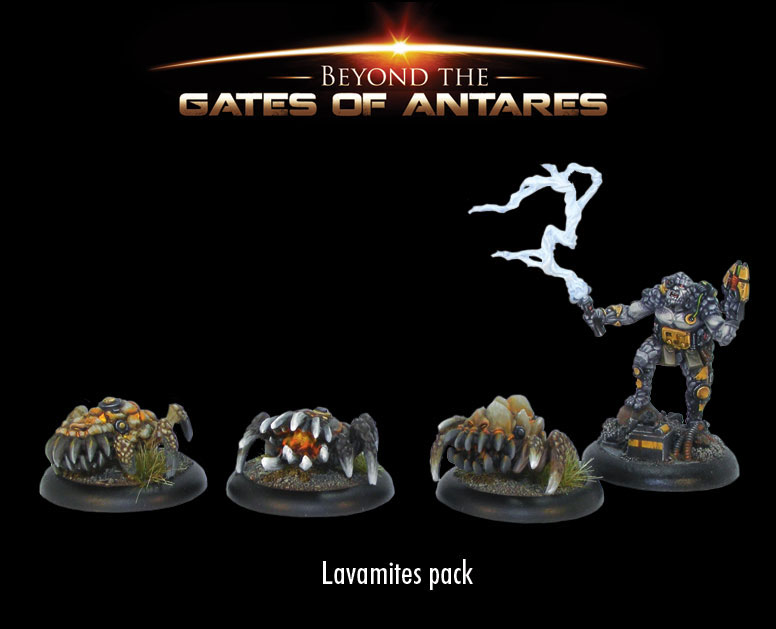
Our second unit of painted Boromites are the strange creatures native to the Borom asteroid belt known as Lavamites and sometimes as Rock Dogs. These creatures are used as working animals by the Boromites because, being organic after a fashion, they are invisible to nanite probes. Although nominally labour organisations, the Guilds include some of the most dangerous criminal elements in Antarean space, avoiding technology that would enable them to be traced or readily identified. Receptors hammered into the Lavamites’ scales enable Boromite handlers to control them, sending the creatures scurrying deep into fissures to sniff out valuable ores, or turning them into monstrous attack hounds. Not only do Lavamites have jaws that can (and do) crush rock, when threatened they can superheat their stomach contents and spit molten rock. As if this were not bad enough, the Lavamite is only the tiny juvenile stage of a species prevented from growing further by implanted receptor nodes. Only when new stock is needed do the Boromites allow their charges to mature into gigantic adults.

